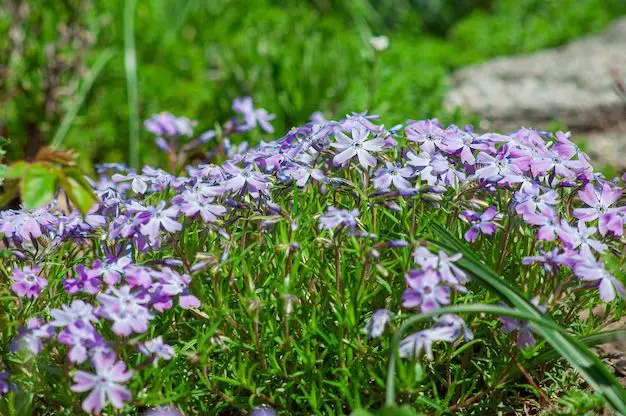Purple flowering ground covers are a beautiful way to add color and texture to any outdoor space. Choosing the right purple ground cover depends on factors like sunlight, climate, and maintenance requirements. Some popular purple flowering ground covers include catmint, creeping phlox, ajuga, verbena, and violets.
Catmint
Catmint (Nepeta) is a low-growing perennial ground cover that produces clusters of small purple flowers in late spring and summer. There are several catmint varieties to choose from, including Walker’s Low, Six Hills Giant, and Junior Walker. Catmint thrives in full sun to partial shade and grows 12-18 inches tall with a 2-3 foot spread. It has aromatic gray-green foliage and looks great in flower beds, rock gardens, and along paths and walkways. Catmint is drought tolerant once established and attracts butterflies and pollinators.
Creeping Phlox
Creeping phlox (Phlox subulata) is a popular low-growing perennial ground cover that produces a carpet of green foliage and blankets itself in purple, pink, blue, or white flowers in early spring. Creeping phlox grows 3-6 inches tall and spreads 12-18 inches. It grows best in full sun and well-drained soil. This hardy plant thrives in USDA zones 3-9. Creeping phlox looks beautiful in rock gardens, edging walkways, in containers, and cascading down walls and slopes. It’s also a great choice for covering bare patches between other plants.
Ajuga
Ajuga, also known as bugleweed, is an easy-care perennial ground cover. Ajuga reptans is a common variety with deep purple flower spikes that bloom in the spring and early summer. Ajuga grows 4-8 inches tall and spreads by runners to form a dense mat. It thrives in partial shade to full shade. Ajuga plants are hardy in USDA zones 3-9. This ground cover looks great under trees and shrubs and between stepping stones. Once established, ajuga is drought tolerant and requires little maintenance to control its spread.
Verbena
Certain species of verbena make excellent purple flowering ground covers. Verbena canadensis, also called Canadian vervain, is a short-lived perennial ground cover with clusters of tiny purple flowers from early summer to early fall. It grows 1-3 feet tall and spreads 1-3 feet wide. Another option is Moss verbena (Verbena tenuisecta), which forms a very low spreading mat of foliage covered in purple flowers in summer. Both verbenas prefer full sun and grow well in poor, rocky soil and hot, dry areas. They attract butterflies and require minimal water and care once established.
Violets
Several species of violets produce purple flowers and make lovely ground covers. Sweet violet (Viola odorata) and common blue violet (Viola sororia) spread by rhizomes to form dense, low-growing colonies of heart-shaped foliage topped with purple blooms in spring. Both grow 4-6 inches tall and prefer partial to full shade. Johnny jump ups (Viola tricolor) also produce cute little purple and white blooms on mounding 6-10 inch tall plants that self-seed freely. Violets thrive in moist, rich soil and brighten up areas under trees or at the edge of woodlands. They work well between garden stepping stones and in containers.
Planting and Care
When planting purple flowering ground covers, prepare the soil by removing weeds, working in compost, and ensuring adequate drainage. Space plants according to their expected spread size. Water new plantings regularly until their root systems are established. Apply a 2-3 inch layer of mulch around plants to help retain soil moisture and discourage weeds. Most perennial ground covers require very little maintenance once established. Trim plants after flowering to encourage a tidy, compact shape and additional blooms. Divide overcrowded plants every 2-3 years in early spring or fall.
Conclusion
Purple flowering ground covers provide a stunning way to carpet the ground and add splashes of color to any landscape. Catmint, creeping phlox, ajuga, verbena, and violets are excellent options that offer low-growing purple blooms. With proper planting and care, these rugged perennials will create beautiful, low-maintenance ground covers for years to come. Choose the right plant for your sunlight and soil conditions, give it adequate water until established, and sit back and enjoy the gorgeous flowers.
